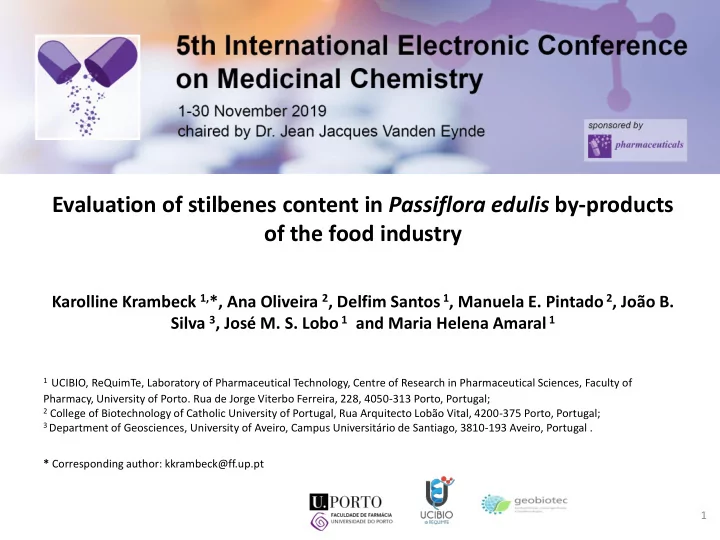

Evaluation of stilbenes content in Passiflora edulis by-products of the food industry Karolline Krambeck 1, *, Ana Oliveira 2 , Delfim Santos 1 , Manuela E. Pintado 2 , João B. Silva 3 , José M. S. Lobo 1 and Maria Helena Amaral 1 1 UCIBIO, ReQuimTe, Laboratory of Pharmaceutical Technology, Centre of Research in Pharmaceutical Sciences, Faculty of Pharmacy, University of Porto. Rua de Jorge Viterbo Ferreira, 228, 4050-313 Porto, Portugal; 2 College of Biotechnology of Catholic University of Portugal, Rua Arquitecto Lobão Vital, 4200-375 Porto, Portugal; 3 Department of Geosciences, University of Aveiro, Campus Universitário de Santiago, 3810-193 Aveiro, Portugal . * Corresponding author: kkrambeck@ff.up.pt 1
Evaluation of stilbenes content in Passiflora edulis by- products of the food industry Graphical Abstract 2
Abstract It has been reported that the antioxidant activity of the passion fruit seeds oil is comparable to that of ascorbic acid, due to a high content of polyphenols such as stilbenes. The aim of this study was to use the residues from the Madeira Island food industry to produce passion fruit seed extracts by Soxhlet and Ultrasound methods, using acetone and ethanol, in order to determine the presence of stilbenes (piceatannol and resveratrol) by High-performance liquid chromatography (HPLC). The extracts obtained by the ultrasound method showed high piceatannol and resveratrol content, while the extracts produced by Soxhlet and the commercial oil showed none of these stilbenes. These results suggest that passion fruit oil from Madeira Island can be used by the pharmaceutical and cosmetics industry because of its potential to reduce oxidative stress (ROS). Keywords: piceatannol; resveratrol; passion fruit seeds oil, by-products 3
Introduction It has been shown that passion fruit seeds oil may be used as an efficient antioxidant. Food waste is a source of valuable compounds for the pharmaceutical and cosmetic industry, since only passion fruit pulp is used by the food industry and the seeds are discarded [1,2]. [1] Oliveira, R.C.; Barros, S.T.D.; Gimenes, M.L. The extraction of passion fruit oil with green solvents. J. of Food Eng. 2013 , 117 , 458-463. [2] Krambeck K, Santos D, Oliveira A, Pintado ME, Silva JB, Lobo JMS, Amaral MH. Optimization of extraction parameters on the antioxidant activity of passion fruit waste. Acad. J. Med. Plants. 2018 , 6(8): 209-213.
Introduction Piceatannol (3,3 ’, 4 ’, 5-trans-tetrahydroxystilbene) is a polyphenolic compound that can be converted to resveratrol. Piceatannol has been found in various plants, including grapes, passion fruit, white tea, rhubarb, peanuts, and black tea [3,4]. The aim of this study was the extraction of oil from by-products of Passiflora edulis from Madeira Island food industry and the determination of the presence of stilbenes, piceatannol and resveratrol, by HPLC, as well as the comparison with a commercial passion fruit seeds oil. [3] Piotrowska H, Kucinska M, Murias M.Biological activity of piceatannol: Leaving the shadow of resveratrol. Mut. Res. 2012 , 750(1): 60-82. [4] Matsui, Y.; Sugiyama, K.; Kamei, M.; Takahashi, T.; Suzuki, T.; Katagata, Y.; Ito, T., Extract of passion fruit (Passiflora edulis) seed containing high amounts of piceatannol inhibits melanogenesis and promotes collagen synthesis. J Agric Food Chem 2010 , 58 (20), 11112-8.
Introduction Passiflora edulis Conditions: seeds - HPLC Waters 2690 Separations Ultrasound Soxhlet assisted Extraction Module, photodiode array detector Extraction (PDA-Waters 996). Commercial Ethanol Acetone oil - 20 µl aliquot of the filtered extract was injected onto a Waters ACE HPLC Analysis Equivalence C18 column (250 x 4.6 mm i.d.; 5µm particle size). - The mobile phases: (A) water with 0.1 % formic acid and (B) methanol Piceatannol Resveratrol with 0.1% formic acid. 6
Results and discussion 210,8 0,60 0,50 210,8 0,40 AU 0,30 Piceatannol 0,20 304,2 Resveratrol Ultrasound Extraction 323,2 0,10 484,2 0,00 40 250,00 300,00 350,00 400,00 450,00 500,00 550,00 nm 35 Piceatannol and resveratrol UV 30 Piceatannol µg/ml spectra of Ethanol extract 25 Resveratrol 20 1,00 214,3 15 0,80 10 5 304,2 0,60 209,6 0 AU Piceatannol Ethanol Acetone 0,40 0,20 323,2 Resveratrol 0,00 250,00 300,00 350,00 400,00 450,00 500,00 550,00 nm Piceatannol and resveratrol UV spectra of Acetone extract 7
Results and discussion Ultrasound Extraction A general overview of the results obtained by other authors allows to conclude that the Ultrasound method is faster, more efficient and more selective for polyphenols than the Soxhlet method [5]. [5]. Santos, D.T.; Cavalcanti, R.N.; Rostagno, M.A.; Queiroga, C.L.; Eberlin, M.N.; Meireles, M.A.A. Extraction of polyphenols and anthocyanins from the jambul (Syzygium cumini) fruit peels. Food Pub. Hea. 2013 , 3, 12-20 . 8
Results and discussion Soxhlet Extraction There is no evidence of the presence of piceatannol and resveratrol in both extracts obtained by Soxhlet. The chromatograms showed unknown peaks. Although some peaks showed the same retention time, they did not absorb at the same UV wavelength as piceatannol and resveratrol. 207,3 237,9 0,80 3,00 0,70 2,50 0,60 210,8 2,00 0,50 AU 0,40 AU 1,50 0,30 1,00 213,2 0,20 260,3 293,5 0,50 0,10 299,4 484,2 0,00 0,00 322,0 250,00 300,00 350,00 400,00 450,00 500,00 550,00 250,00 300,00 350,00 400,00 450,00 500,00 550,00 nm nm UV spectra of ethalolic UV spectra of Acetone extract extract 9
Results and discussion Chromatograms of the samples: (a) Ethanol extract by Ultrasound method; (b) Ethanol extract by Soxhlet method; (c) Acetone extract by Ultrasound method; (d) Acetone extract by the Soxhlet method; (e) commercial oil. As can be seen, piceatannol and resveratrol were not detected in the commercial passion fruit oil. 10
Conclusions - The present study showed that in the extracts of Passiflora edulis by-products obtained by Soxhlet and in the commercial oil neither resveratrol nor piceatannol were identified. - The extracts obtained by the Ultrasound Extraction method, using etanol or acetone, represents a significant source of stilbenes such as piceatannol and resveratrol. - These extracts showed promising antioxidant activity and added value. - The results obtained also suggest the possibility of green production of Passiflora edulis seeds oil and the potential interest of this product to food, cosmetic and pharmaceutical industries. 11
Acknowledgments 12
Recommend
More recommend